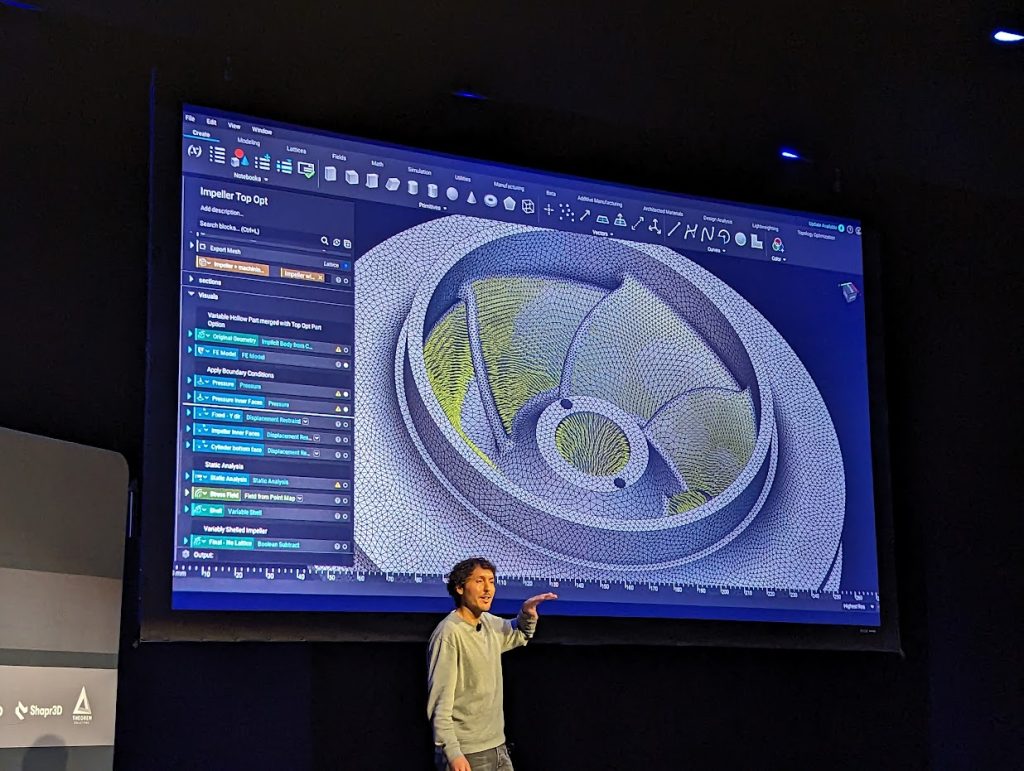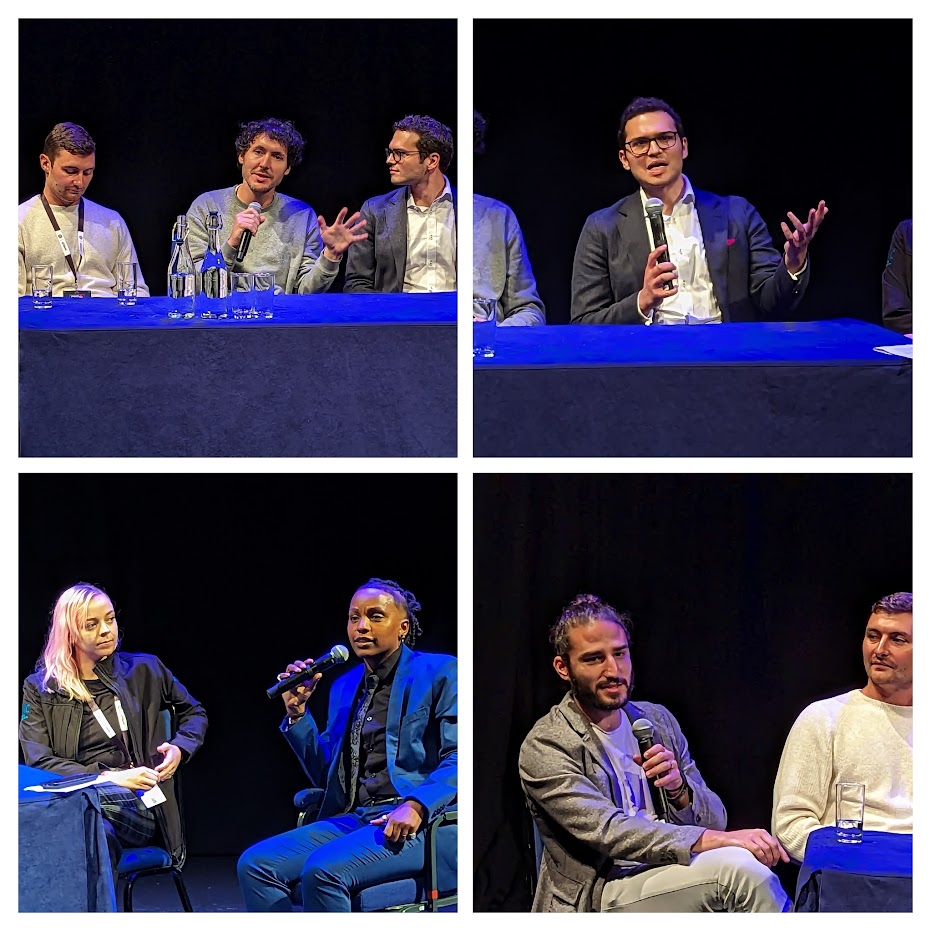3D Printing Industry attended DEVELOP3D LIVE in Coventry, UK, to hear from experts in advanced design software.
“Design software itself has always been a bottleneck. Computational design can open up the heart of what’s possible,” believes Bradley Rothenberg, CEO of nTop. nTop provides advanced engineering software, including tools for topology optimization and generative design.
Generative design is an approach that starts where other design methods end. The goal is specified in the form of constraints, and via an iterative process, designs are generated with the framework that can reach that goal. Topology optimization is more commonly used later in the design cycle. User-specified constraints are coupled with an algorithm to find the optimal balance of materials.
Rothenberg joked that even his company, previously known as nTopology, has been optimized.
Are the companies in this article leading the industry? Nominate now in the 2023 3D Printing Industry Awards.

nTop CEO Expounds on Advanced Design’s Future
“We can manufacture more complex parts than we can design,” Rothenberg asserted. Or drawing on a quote from a prior presentation, “Expanding the art of what’s possible.”
According to Rothenberg, the crux of the issue lies in the outdated “digital tool stack” that has failed to keep pace with cutting-edge digital manufacturing capabilities. “You can make more complex shapes [with additive manufacturing], but our digital tool stack was never designed for that.” Rothenberg contended that despite the leaps in digital innovation, many principles in part engineering “don’t look a lot different than what we were doing in the 1980s with drafting tables.”
Presenting an example of a Grundfos industrial pump, Rothenberg claimed it might look similar to their ’90s counterparts. However, what has changed is the increased integration of electronics and software. The solution, Rothenberg believes, may lie in the emergent concept of generative design, which distinguishes the logical from the physical processes of creating a part. This approach allows designers to “define the requirements or the functional requirements upfront” and lets the software produce the necessary system.
nTop’s “field-driven design capability” integrates real-world physics directly into design parameters, enabling designers to create models grounded in reality. Automation allows teams to “rerun, reuse, and share” designs, fostering collaboration and efficiency.
Rothenberg points out how their modernized strategies addressed complexity challenges. “In software systems, we have model-based design, continuous integration, and continuous deployment. But the current toolset [for mechanical design] was never built for that,” Rothenberg says. He uses the term ‘generative design’ as a possible solution, emphasizing the need to differentiate between logical and physical processes.
Rothenberg described nTop’s technology: “With implicit modeling, you’re feeding requirements into it, those requirements are being run in a notebook, you’re composing those blocks together.” This process, leveraging a differentiated tech stack, allows for significantly more intricate part design and improved performance.
The CEO described an innovative use case: an aerospace heat exchanger that promises an 85% reduction in volume, superior heat transfer, and enhanced pressure drop compared to traditional models. This heat exchanger, developed in collaboration with the Air Force Research Lab, aims to rectify persistent issues in Blackhawk helicopters, where traditional heat exchangers often fail.
Another standout project comes from Life Enabled, which produces “the world’s most advanced prosthetics” in Guatemala. Leveraging nTop’s technology, they’ve expedited the design process for customized prosthetics, ensuring a turnaround of less than a week. Rothenberg also drew attention to Ocado’s series 600 robot, hinting at its transformative potential for warehouse operations.

The Future of Computational Design and 3D printing
Rothenberg was later joined on stage for a panel discussion around computational design, moderated by SJ from organizers Develop3D.
The industry experts weighed in on the future and application of computational design.
Moritz Valentino Huber of software developer Hyperganic highlighted the success of dental aligners as a consumer product that has greatly benefited from computational design and additive manufacturing. He also alluded to the need for a mentality shift for industries to harness its potential fully.
nTop’s CEO underscored the value of customization in products such as dental aligners. He highlighted the transformative impact of computational design on system-level performance, asserting, “What we’re missing right now is what’s the impact of the computational design of a part and how that impacts the overall system’s level performance.”
Alice Wise, a Research Engineer from the Manufacturing Technology Centre (MTC), urged participants to look beyond additive manufacturing and consider a more comprehensive system-level approach. She mentioned, “There’s been a lot of AI and machine learning development in both Siemens and SolidWorks. It’s about interrogating [machine learning] models [to see] can I combine these two things while doing additive manufacturing, like part consolidation?”
Overall, the consensus among the experts is that computational design holds transformative potential across various industries, and the real challenge lies in harnessing it effectively at a system-wide level.

Barriers to Computational Design Adoption
Discussing the hurdles faced by the computational design sector, Alice Wise, at MTC cited “conventional and historical thinking” as primary obstacles. She emphasized that although new startups are revolutionizing design ideas, these innovations face resistance, especially from traditional industries reliant on time-tested methods and tools. “There are so many barriers to entry on things like aerospace, in terms of standardizing materials, introducing anything new that’s not historically been validated,” she noted. Wise stressed the importance of education, case studies, and partnerships with large companies.
Alex Pluke, GM and CTO at software developer Additive Flow, highlighted the financial aspects, stating, “It’s more than just legacy thinking. It’s, where is the money?” He mentioned the significant shifts in stock market investments due to technology adoption and pointed out that technologies like AI have received massive investments due to their newfound accessibility.
Rothenberg, CEO of nTop, suggested that the critical bottleneck is people’s mindset and the business case supporting innovations. He called for industry influencers to push the boundaries and show engineers the realm of possibilities.
Moritz Valentino Huber of Hyperganic stressed the “knowledge gap” between different stages in the value chain, with design, simulation, and production often not in sync.
Mechanical-Software Convergence: Future Integration
“How do the requirements feed between the two disciplines?” queried Rothenberg, emphasizing the incongruity of installing box-like electronics in curved airplane structures and the need for a more cohesive design approach. “It’s not just about the speed of design,” Rothenberg elaborated, “but understanding how one change affects the whole system. The quicker you understand that, the better you can get to a desired result.”
Alex Pluke, GM and CTO at Additive Flow, touched on the evolution he witnessed: “You’re starting to see this convergence between stages and scales,” referencing his observations from a recent trip to Israel and the developing landscape of 3D printed electronic systems. Yet, he also underscored the challenges of interdisciplinary collaboration, rhetorically asking if electronic and chemical engineers, for example, always “use the same language” and have “the same priorities and goals.”
Matt Shomper, Founder of LatticeRobot, posited a shift in the approach to traditional CAD systems. He believes the next frontier in computational design goes beyond creating tangible products, encompassing a broader systems engineering scope. “Systems Engineering is more than just giving you a physical product; it’s multifaceted. It’s this multiphysics assessment of your design domain to get to a solution,” Shomper said. He highlighted the potential of CAD tools for complex data manipulation, effectively bridging the realms of design and data processing.
Shomper emphasized, “Speaking as somebody who comes from medical devices, there’s already been penetration into the market.” He cautioned against underestimating the challenges faced in these sectors by noting, “Once you start getting into any regulated market whatsoever… there’s a significant hurdle that needs to be overcome.”
SJ, the panel’s moderator, resonated with these sentiments, sharing personal experiences of employing computational tools like nTop for unconventional data processing during grad school. This venture sometimes led them “down a rabbit hole.”
The consensus leaned towards a future where there’s an inevitable merger of mechanical design with the software realm, enabling products and solutions that are both efficient and effective.

Changing Legacy Mindsets in Tech
The focus turned to the challenges of changing legacy mindsets in the technological field.
Matt Shomper of LatticeRobot emphasized that while he is often cynical about humanity’s openness to change, he believes presenting data is paramount. He said, “The very first step is to back whatever you say with data.” Many are naturally suspicious of unfamiliar technologies, and showcasing compelling data can initiate a dialogue.
Bradley Rothenberg pointed to examples of innovation, like Joby Aviation, that have effectively adopted 3D printed components in their test flights. He highlights the importance of working within existing systems but pushing their boundaries. Rothenberg cited an example elsewhere instance where a software engineer leveraged GitHub, a free tool, to meet FDA qualifications instead of traditional PLM systems.
Alex Pluke from Additive Flow drew attention to the secrecy surrounding the industry’s leading-edge technologies. He stated that while it’s understandable companies want to protect their intellectual property, there’s a need to find a balance to inspire innovation. He also highlighted the importance of human-driven design thinking, stating, “I think just as an overarching point when we’re looking at things like AI and computational engineering… these tools can empower people.”
Alice Wise mirrored Shomper’s sentiments on skepticism towards new technology, comparing it to the slow acceptance of electric cars.
In summary, the panelists agreed that while skepticism towards new technologies remains, there’s a rising trend toward adopting advanced tech solutions. The key is to present compelling data, think innovatively within existing frameworks, and draw inspiration from industry leaders while navigating the balance between secrecy and shared knowledge.
Alice Wise touched on the complexities of generative design and topology optimization, emphasizing the need for clear goals. She said, “Generative design… requires you to have some goal in mind.” Later, she discussed how AI tools might better capture and codify design requirements.
The DEVELOP3D LIVE panel provided a notable discourse between users and developers of advanced design software. Both technical advancements and sector-specific constraints will shape future trajectories in technology adoption.
Featured image shows Develop3D Live panel on Computational Design. Photos by Michael Petch.
Subscribe to the 3D Printing Industry newsletter to keep up to date with the latest 3D printing news. You can also follow us on Twitter, like our Facebook page, and subscribe to the 3D Printing Industry Youtube channel to access more exclusive content.
Are you interested in working in the additive manufacturing industry? Visit 3D Printing Jobs to view a selection of available roles and kickstart your career.



